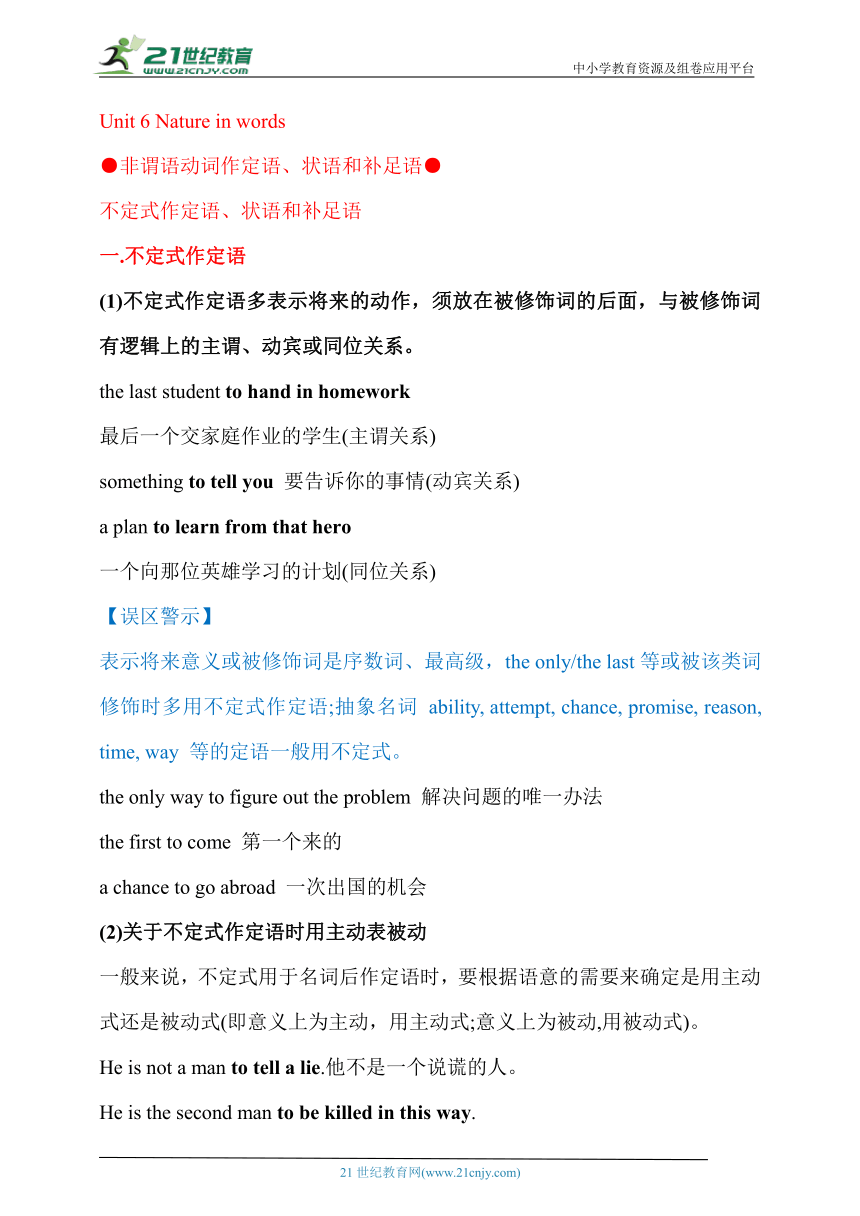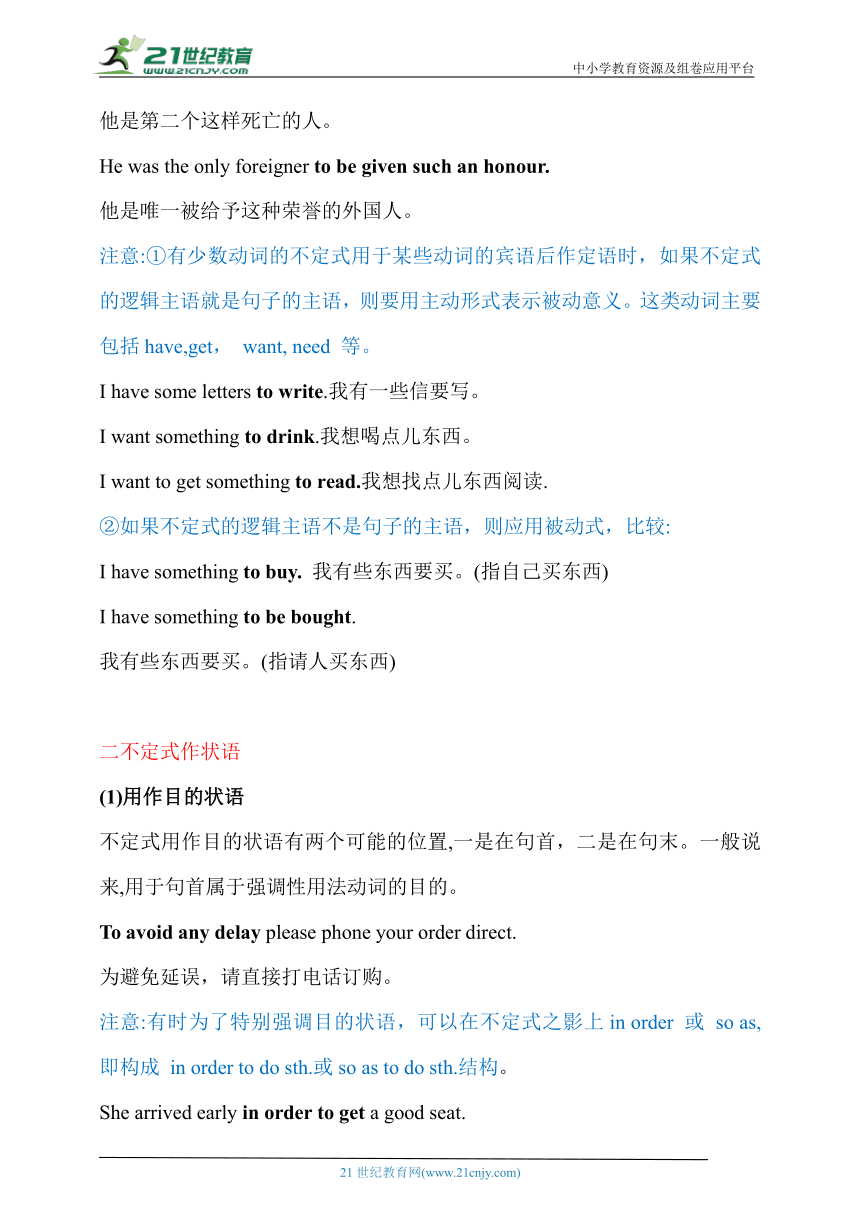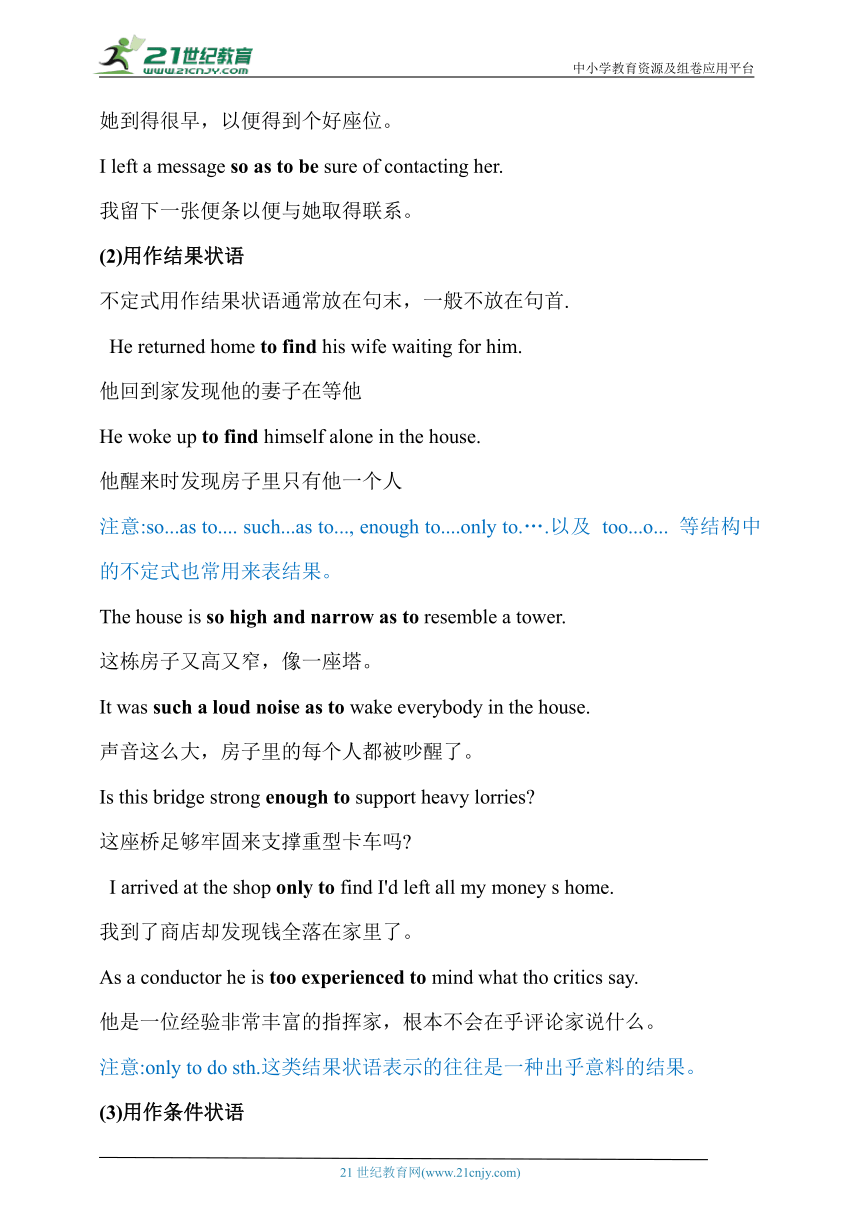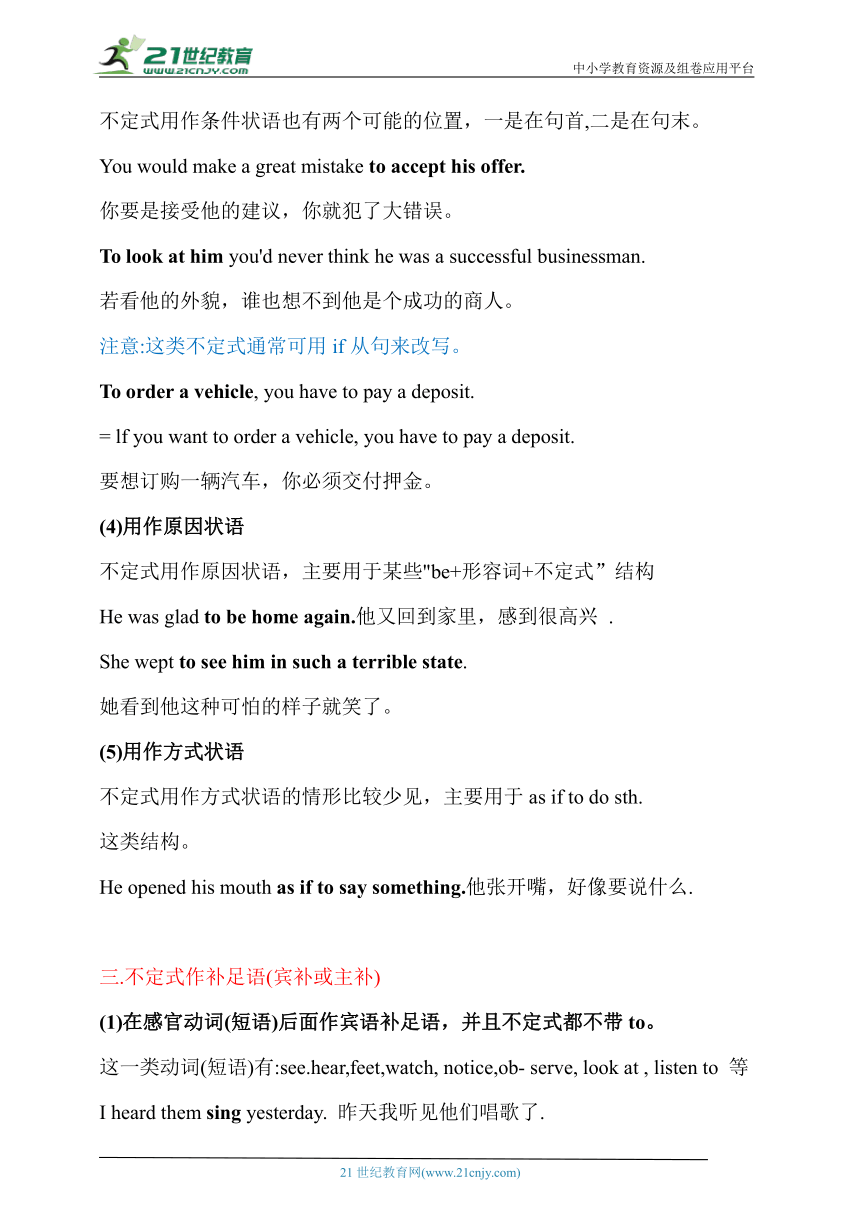(2019外研版)选修三unit 6 Nature in words 讲义(精讲)
文档属性
| 名称 | (2019外研版)选修三unit 6 Nature in words 讲义(精讲) |  | |
| 格式 | doc | ||
| 文件大小 | 289.4KB | ||
| 资源类型 | 试卷 | ||
| 版本资源 | 外研版(2019) | ||
| 科目 | 英语 | ||
| 更新时间 | 2024-05-06 20:48:37 | ||
图片预览





文档简介
中小学教育资源及组卷应用平台
Unit 6 Nature in words
●非谓语动词作定语、状语和补足语●
不定式作定语、状语和补足语
一.不定式作定语
(1)不定式作定语多表示将来的动作,须放在被修饰词的后面,与被修饰词有逻辑上的主谓、动宾或同位关系。
the last student to hand in homework
最后一个交家庭作业的学生(主谓关系)
something to tell you 要告诉你的事情(动宾关系)
a plan to learn from that hero
一个向那位英雄学习的计划(同位关系)
【误区警示】
表示将来意义或被修饰词是序数词、最高级,the only/the last等或被该类词修饰时多用不定式作定语;抽象名词 ability, attempt, chance, promise, reason, time, way 等的定语一般用不定式。
the only way to figure out the problem 解决问题的唯一办法
the first to come 第一个来的
a chance to go abroad 一次出国的机会
(2)关于不定式作定语时用主动表被动
一般来说,不定式用于名词后作定语时,要根据语意的需要来确定是用主动式还是被动式(即意义上为主动,用主动式;意义上为被动,用被动式)。
He is not a man to tell a lie.他不是一个说谎的人。
He is the second man to be killed in this way.
他是第二个这样死亡的人。
He was the only foreigner to be given such an honour.
他是唯一被给予这种荣誉的外国人。
注意:①有少数动词的不定式用于某些动词的宾语后作定语时,如果不定式的逻辑主语就是句子的主语,则要用主动形式表示被动意义。这类动词主要包括have,get, want, need 等。
I have some letters to write.我有一些信要写。
I want something to drink.我想喝点儿东西。
I want to get something to read.我想找点儿东西阅读.
②如果不定式的逻辑主语不是句子的主语,则应用被动式,比较:
I have something to buy. 我有些东西要买。(指自己买东西)
I have something to be bought.
我有些东西要买。(指请人买东西)
二不定式作状语
(1)用作目的状语
不定式用作目的状语有两个可能的位置,一是在句首,二是在句末。一般说来,用于句首属于强调性用法动词的目的。
To avoid any delay please phone your order direct.
为避免延误,请直接打电话订购。
注意:有时为了特别强调目的状语,可以在不定式之影上in order 或 so as,即构成 in order to do sth.或so as to do sth.结构。
She arrived early in order to get a good seat.
她到得很早,以便得到个好座位。
I left a message so as to be sure of contacting her.
我留下一张便条以便与她取得联系。
(2)用作结果状语
不定式用作结果状语通常放在句末,一般不放在句首.
He returned home to find his wife waiting for him.
他回到家发现他的妻子在等他
He woke up to find himself alone in the house.
他醒来时发现房子里只有他一个人
注意:so...as to.... such...as to..., enough to....only to.….以及 too...o... 等结构中的不定式也常用来表结果。
The house is so high and narrow as to resemble a tower.
这栋房子又高又窄,像一座塔。
It was such a loud noise as to wake everybody in the house.
声音这么大,房子里的每个人都被吵醒了。
Is this bridge strong enough to support heavy lorries
这座桥足够牢固来支撑重型卡车吗
I arrived at the shop only to find I'd left all my money s home.
我到了商店却发现钱全落在家里了。
As a conductor he is too experienced to mind what tho critics say.
他是一位经验非常丰富的指挥家,根本不会在乎评论家说什么。
注意:only to do sth.这类结果状语表示的往往是一种出乎意料的结果。
(3)用作条件状语
不定式用作条件状语也有两个可能的位置,一是在句首,二是在句末。
You would make a great mistake to accept his offer.
你要是接受他的建议,你就犯了大错误。
To look at him you'd never think he was a successful businessman.
若看他的外貌,谁也想不到他是个成功的商人。
注意:这类不定式通常可用if从句来改写。
To order a vehicle, you have to pay a deposit.
= lf you want to order a vehicle, you have to pay a deposit.
要想订购一辆汽车,你必须交付押金。
(4)用作原因状语
不定式用作原因状语,主要用于某些"be+形容词+不定式”结构
He was glad to be home again.他又回到家里,感到很高兴 .
She wept to see him in such a terrible state.
她看到他这种可怕的样子就笑了。
(5)用作方式状语
不定式用作方式状语的情形比较少见,主要用于as if to do sth.
这类结构。
He opened his mouth as if to say something.他张开嘴,好像要说什么.
三.不定式作补足语(宾补或主补)
(1)在感官动词(短语)后面作宾语补足语,并且不定式都不带to。
这一类动词(短语)有:see.hear,feet,watch, notice,ob- serve, look at , listen to 等
I heard them sing yesterday. 昨天我听见他们唱歌了.
Did you see him go out 你看见他出去了吗
I felt something crawl up my leg.我感到有什么东西爬到我腿上了.
(2)在使役动词后作宾语补足语,不定式不带to。
这一类动词有:make,let,have 等。转为被动语态时,其后通常都用带to的不定式(have没有被动语态)。
What would you have me do 你要我做什么
She made him give up smoking.她让他戒烟了。
Let him do whatever he wishes to do.他想做什么就让他做吧。
(3)在表示心理状态的动词后作宾语补足语。
这类动词有:
consider,think, believe, discover, find, imagine,judge,suppose 等。这类动词后的不定式通常是“to be+形容词或名词”结构,think,consider,prove,find 后的 to be 常可省略。
We consider him (to be) a good teacher.我们认为他是一个好老师。
He proved that theory (to be) very important.
他证明那个理论是很重要的。
I thought her ( to be ) nice and honest the first time I met her.
我第一次见到她的时候就认为她人很好,很诚实.
在表示情感状态的动词后作宾语补足语。
这类动词有:love, like,prefer,hate,want.wish 等。
I'd prefer you to leave him alone.我希望你不要打扰他。
(5)动词 advise,allow,ask, beg, command, tell, invite. force, oblige, get, help, encourage, persuade, permit, remind, request, order, warn, cause,forbid 等后面多接不定式作宾语补足语。
We don't allow such things to happen again.
我们不客许这种事情再发生。
Most of the parents agree to forbid their children to smoke.
大多数父母都同意禁止自己的孩子抽烟。
She requested him to go with her.
她要求他一同去.
(6)动词不定式也可作一些动词短语的宾语补足语。
I'm waiting for James to arrive.我正在等詹姆斯的到来.
He's arranged for a car to pick them up at the station.
他已经安排了一辆汽车丢车站接他们.
(7)动调不定式作宾补。如果用于被动语态,宾补就变为主补。
接不定式作宾语补足语的大部分动词(have,let,notice. watch 等除外)都可以作被动句中的谓语,这样在主动句中作宾语补足语的不定式(语)便在被动句中作主语补足语.
The room was found to be empty.
那个房间被发现是空的.(to be empty是主语补足语).
The young man was considered to have great promise.
这个青年被认为大有前途:(to have great promise 是主语补足语)
注意:①作宾语补足语的不带o的不定式在被动句中作主语补足语时须带to.
They were made to wait for hours.他们被迫等了好几个小时.
②不定式(短语)在“Sb./Sth.+be+及物动词的过去分询+不定式(短语)”句式中作主语补足语
It is said that he is from New Zealand.
= He is said to be from New Zealand.
据说他是新西兰人。(to be...是主语补足语)
v-ing 形式作定语、状语和补足语
一.v-ing 形式作定语
The sleeping child is only five years old.那个睡觉的孩子只有五岁.
注意:-ing作定语时,如果-ing只是一个单词,就位于其修饰的名词之前,如果是-ing短语,就位于其修饰的名词之后;v-ing作定语时,被-ng所修饰的名词就是该v-ing的逻辑主语。另外,-ing作定语时,其动作和句子谓语动词所表示的动作是同时进行的。如果不是同时进行的,就不能用v-ing作定语,要使用定语从句
The girl who wrote a letter there yesterday can speak English very well.昨天在那儿写信的那个女孩英语说得很好。
V.-ing 形式作状语
(1)用作时间状语
Seeing Tom , I couldn't help thinking of his younger brother.
看到汤姆我情不自禁地想起了他的弟弟。
注意:分词在句中作时间状语时,其前一般可加when或 while.
When crossing street, you must be careful.
过马路时,你必须小心。
(2)用作原因状语
Being ill, he didn't go to school yesterday.
由于生病,他昨天没去上学。
(3)用作方式或伴随状语
Mary stood at the school gate waiting for Betty.
玛丽站在学校门口等贝蒂.
(4)用作结果状语
Fifteen million trees had been blown down by the high winds, blocking roads, paths and railway lines.
1500万棵树被狂风刮倒,把大小道路和铁路线都堵塞了.
三.v-ing形式作宾语补足语
We can see steam rising from the wet clothes.
我们可以看到蒸汽从湿衣服上冒出来。
注意:当v-ing在复合宾语中作宾语补足语时,句中宾语就是这个v-ing的逻辑主语,可以带有这种复合宾语的动词有see,watch, hear,observe,feel,find,have, keep 等。
过去分词作定语、状语和补足语
一.过去分词作定语
过去分词作定语时,如果这个分词是一个单词,就位于其修饰的名词之前,如果是分词短语,就位于其修饰的名词之后。
The stolen car was found by the police last week.
警察上周找到了被盗的汽车。
二.过去分词作状语
过去分词作状语时,相当于一个状语从句,该结构的逻辑主语一般都是主句的主语,是过去分词所表示意义的逻辑宾语。为了使作状语的过去分词意义更加明确,常在分词前加 when,if,while,though,as 等连词。
Seen from the hill/When seen from the hill, our town looks beautiful.
从山上看,我们的城镇看起来很美.
Given more time/If given more time, we could do it better.
如果给我们更多的时间,我们可以把它做得更好。
(we是该结构的逻辑主语,是give的逻辑宾语)
三.过去分词作宾语补足语
过去分词作宾语补足语时,句中的宾语就是其逻辑主语.
When I opened the door, I found the ground covered fallen leaves.
当我打开门时,我发现地上覆盖着落叶。
注意:动词have后的复合宾语中,宾语补足语如为过分词,常表示该分词所表示的动作是由别人来执行的不是句中主语自己来执行的。
I had my bike repaired yesterday.
昨天我(找别人)把我的自行车给修了。
难点1:insist that...
教材例句
...I must insist that last night's fall of snow here was an event.……
我也得坚持说:“昨晚这儿的那场雪是件大事。
insist意为“坚持要求”。后接that从句时,从句要用虚拟语气,即谓语用(should)do;意为“坚持认为”,后接 that 从句时,从句不用虚拟语气。
suggest用法与insist类似
suggest 意为“建议”.后接 that 从句时。从句要用虚拟语气.即谓语用(should) do;意为“暗示”后接that从句时,从句不用虚拟语气。
宾语从句中的虚拟语气
某些动词后所接的宾语从句要用虚拟语气,用来表示建议、命令和要求等。其谓语形式为“(should+)动词原形”。常见的这类动词有:
advise劝告 determine 决定 decide决定 command 命令
insist 坚持要求 intend打算 order命令 recommend推荐
request 要求 require要求 suggest建议 urge主张
demand要求 desire 渴望 direct 命令
He insisted that he was innocent.他坚持认为自己是清白的。
②)But our___________(insist )it's merely a window has kept them from attempting millions of requests to open the door.
但是我们坚持说那只是一扇窗户,这打消了他们无数次企图打开这扇门的请求。
③ He insisted that it was not his fault and that he(should)be free.
他坚持认为自己没有错,并且坚持要求被释放。
④ She insisted that the man had stolen her wallet and that he (should ) be sent to the police station.
她坚持说那个男人偷了她的钱包并坚决要求把他送到警察局。
The smile on her face suggests that she__________(have) known the secret.
她脸上的微笑暗示她已经知道了这个秘密。
Eye doctors recommend that a child’s first eye exam________(be) at the age of six months old.
眼科医生建议孩子在六个月大的时候进行第一次眼科检查。
难点2. by the time 引导的时间状语从句
教材例句
Then the sun came out, and by the time I had sat down to breakfast it was shining bravely and flushing the snow with delicate pinks.
接着太阳出来了,等到我坐下来吃早餐时,太阳的光彩已是绚烂夺目,给雪地添了一抹柔和的粉红色。
by the time... 意为“到……时候”相当于when 引导的时间状语从句.
I was exhausted by the time I got home.我到家时已经筋疲力尽了.
by the time 可用作连词,意为“到……时为止”,引导时间状语从句。
①by the time+一般过去时,主句通常用过去完成时,表示截止到从句动作发生时,主句动作已经完成。
By the time I got to the station, the train had already gone.
我到达车站时,火车已经开走了。
②by the time+一般现在时(表示将来),主句通常用将来完成时,表示截止到将来某一时间为止,主句动作将已经完成。
By the time you get back, I will have finished the work.
到你回来时,我将已经把工作做完了。
As is often the case with children, Amy was better by the time the doctor arrived.
就像孩子们经常遇到的情况一样,当医生到的时候.艾米好多了.
as引导非限制性定语从旬,对后面的主向进行补充说明
②By the time I got home,! only had a few hours to do my homework , and I had to do it right away.
当我到家的时候,我只有几个小时做家庭作业,我必须马上做.
③ By the time I make enough money, it'll be bought by others!
等我赚够钱的时候,它就被别人买走了!
④By the time Jack returned home from Eng land,his son_________
(graduate ) from college.
当杰克从英格兰回到家时,他的儿子已经大学毕业了.
⑤ By the time Jane gets home , her aunt____________( leave ) for London to attend a meeting.
简到家时.她姑妈将已经前往伦敦去参加一个会议了。
难点3 .with 复合结构
数材例句
...with the faintly flushed snow lining its branches and artfully disposed along its trunk, stood in full sunlight. ……
在阳光的普照之下,屋外的李子树的树干和枝丫被淡粉的积雪精致巧妙地装点着。
构成:with+ 宾语+宾补
常在句中作状语,表示原因、方式、时间、条件或伴随等。
具体形式主要有:
with+宾语+现在分词(主动或正在进行)
with+宾语+过去分词(被动或已经完成)
with+宾语+介词短语动词不定式(尚未发生)
with+宾语+介词短语
With+形容词/副词/名词
He lay on the grass , with his eyes looking at the sky.
他躺在草地上,眼睛望着天空。
With his hair cut, he looked much younger.
由于理了发,他看起来年轻多了。
With so much work to do, I can't go on holiday.
有这么多工作要做,我不能去度假。
He used to sleep with the windows open.他过去常常开着窗户睡觉。
with 复合结构在句中还可作定语。
Do you know the lady with a baby in he arms
你认识那个抱着一个婴儿的女士吗
She saw a river with red flowers and green grass on both sides.
她看到一条两岸长着红花、绿草的河。
Already well over 400 of the total of 6. 800 languages are close to extinction, with only a few elderly speakers left.
在总共6800种语言中已经有400多种濒临灭绝,只剩下少数老年人在使用.
be close to (doing) sth. 快要(做)某事
②All of.work at the kitchen table, with my mom________(film)the annual event.
我们所有人都在厨房的餐桌上辛勤地工作着,而我妈妈则在拍摄这一年一度的活动。
③I encountered many hikers who were headed to a distant camp ground with just enough time________ (get) there before dark.
我遇到许多徒步旅行者,他们正前往一个遥远的露营地.刚好有足够的时间在天黑前到达那里。
④ With a book in her hand, Miss Gao walked into the classroom.
高老师手里拿着一本书,走进了教室。
⑤ Suddenly, he saw a car with its bright lights___________.
突然,他看见一辆亮着灯的汽车。
难点4:no matter whether
引导让步状语从句
教材例句:
..no matter whether it's a flower... or the rain. ……
不管它是一朵花……还是一场雨。
no matter whether 常与or搭配,表示“无论……还是……”。
no matter + what/who/when/where/which /how
=whatever/whoever/whenever/ wherever/whichever/however
无论……,可引导让步状语从句。
Whatever(=No matter what)happens we must keep calm.
无论发生什么,我们都必须保持镇定。
Wherever(=No matter where)I go I always meet interesting people.
无论我去哪里,我总会遇见有趣的人。
no matter+what/who/when/where/ which/how 不可以引导主语从句、宾语从句等名词性从句;wh-ever,however则可以。
We won't wait no matter whether he's coming or not.
不管他是否来,我们都不等了。
②..but no matter___________hard I tried, I was always the neglected one.……
但不管我怎么努力,我总是被忽视的那个。
③ Whenever I talked to him, he seemed like a pretty regular guy.
我无论什么时候同他讲话,他都好像是个很正常的人。
④ She has the window open, however cold it is outside.
不管外面多冷,她都开着窗户。
⑤ Your support is important to our work. Whatever you can do helps. 你的支持对我们的工作很重要。无论你能做什么,都会对我们有帮助。
whatever引导主语从句,且在从句中作do的宾语,此时不能换为no matter what
本单元词组:
talk away 不断地说;在说话中度过
alert sb.to sth.让某人意识到某事
target for 以...为目标
come round 发生;降临
cause harm to 对...造成伤害
stand by 支持;袖手旁观;做好准备;站在旁边
break out 爆发;突发
urge...to do 敦促...做...
spend some time doing...花费一些时间做...
early on 在初期;在开始阶段;早先
on...occasion(s)在...场合
at the risk of 冒...的风险
contrast with 与...形成对比;和...相对照
replace...with...把...替换;为...;用...代替...
make oneself aware of 使某人自己意识到
be regarded as 被认为是;被当作是
a target for ...的目标
wake up to 意识到;认识到;醒来发现
up and down 上上下下;来来回回
be of+抽象名词 具有...性质
dozens of很多;许多
fade away逐渐消失
sweep off扫去,大量清除
a pile of一堆;很多
25.a number of 许多
insist on坚持;强调
glare at怒视;瞪着
be aware of意识到
be regarded as被视作;被认为
21世纪教育网 www.21cnjy.com 精品试卷·第 2 页 (共 2 页)
21世纪教育网(www.21cnjy.com)
Unit 6 Nature in words
●非谓语动词作定语、状语和补足语●
不定式作定语、状语和补足语
一.不定式作定语
(1)不定式作定语多表示将来的动作,须放在被修饰词的后面,与被修饰词有逻辑上的主谓、动宾或同位关系。
the last student to hand in homework
最后一个交家庭作业的学生(主谓关系)
something to tell you 要告诉你的事情(动宾关系)
a plan to learn from that hero
一个向那位英雄学习的计划(同位关系)
【误区警示】
表示将来意义或被修饰词是序数词、最高级,the only/the last等或被该类词修饰时多用不定式作定语;抽象名词 ability, attempt, chance, promise, reason, time, way 等的定语一般用不定式。
the only way to figure out the problem 解决问题的唯一办法
the first to come 第一个来的
a chance to go abroad 一次出国的机会
(2)关于不定式作定语时用主动表被动
一般来说,不定式用于名词后作定语时,要根据语意的需要来确定是用主动式还是被动式(即意义上为主动,用主动式;意义上为被动,用被动式)。
He is not a man to tell a lie.他不是一个说谎的人。
He is the second man to be killed in this way.
他是第二个这样死亡的人。
He was the only foreigner to be given such an honour.
他是唯一被给予这种荣誉的外国人。
注意:①有少数动词的不定式用于某些动词的宾语后作定语时,如果不定式的逻辑主语就是句子的主语,则要用主动形式表示被动意义。这类动词主要包括have,get, want, need 等。
I have some letters to write.我有一些信要写。
I want something to drink.我想喝点儿东西。
I want to get something to read.我想找点儿东西阅读.
②如果不定式的逻辑主语不是句子的主语,则应用被动式,比较:
I have something to buy. 我有些东西要买。(指自己买东西)
I have something to be bought.
我有些东西要买。(指请人买东西)
二不定式作状语
(1)用作目的状语
不定式用作目的状语有两个可能的位置,一是在句首,二是在句末。一般说来,用于句首属于强调性用法动词的目的。
To avoid any delay please phone your order direct.
为避免延误,请直接打电话订购。
注意:有时为了特别强调目的状语,可以在不定式之影上in order 或 so as,即构成 in order to do sth.或so as to do sth.结构。
She arrived early in order to get a good seat.
她到得很早,以便得到个好座位。
I left a message so as to be sure of contacting her.
我留下一张便条以便与她取得联系。
(2)用作结果状语
不定式用作结果状语通常放在句末,一般不放在句首.
He returned home to find his wife waiting for him.
他回到家发现他的妻子在等他
He woke up to find himself alone in the house.
他醒来时发现房子里只有他一个人
注意:so...as to.... such...as to..., enough to....only to.….以及 too...o... 等结构中的不定式也常用来表结果。
The house is so high and narrow as to resemble a tower.
这栋房子又高又窄,像一座塔。
It was such a loud noise as to wake everybody in the house.
声音这么大,房子里的每个人都被吵醒了。
Is this bridge strong enough to support heavy lorries
这座桥足够牢固来支撑重型卡车吗
I arrived at the shop only to find I'd left all my money s home.
我到了商店却发现钱全落在家里了。
As a conductor he is too experienced to mind what tho critics say.
他是一位经验非常丰富的指挥家,根本不会在乎评论家说什么。
注意:only to do sth.这类结果状语表示的往往是一种出乎意料的结果。
(3)用作条件状语
不定式用作条件状语也有两个可能的位置,一是在句首,二是在句末。
You would make a great mistake to accept his offer.
你要是接受他的建议,你就犯了大错误。
To look at him you'd never think he was a successful businessman.
若看他的外貌,谁也想不到他是个成功的商人。
注意:这类不定式通常可用if从句来改写。
To order a vehicle, you have to pay a deposit.
= lf you want to order a vehicle, you have to pay a deposit.
要想订购一辆汽车,你必须交付押金。
(4)用作原因状语
不定式用作原因状语,主要用于某些"be+形容词+不定式”结构
He was glad to be home again.他又回到家里,感到很高兴 .
She wept to see him in such a terrible state.
她看到他这种可怕的样子就笑了。
(5)用作方式状语
不定式用作方式状语的情形比较少见,主要用于as if to do sth.
这类结构。
He opened his mouth as if to say something.他张开嘴,好像要说什么.
三.不定式作补足语(宾补或主补)
(1)在感官动词(短语)后面作宾语补足语,并且不定式都不带to。
这一类动词(短语)有:see.hear,feet,watch, notice,ob- serve, look at , listen to 等
I heard them sing yesterday. 昨天我听见他们唱歌了.
Did you see him go out 你看见他出去了吗
I felt something crawl up my leg.我感到有什么东西爬到我腿上了.
(2)在使役动词后作宾语补足语,不定式不带to。
这一类动词有:make,let,have 等。转为被动语态时,其后通常都用带to的不定式(have没有被动语态)。
What would you have me do 你要我做什么
She made him give up smoking.她让他戒烟了。
Let him do whatever he wishes to do.他想做什么就让他做吧。
(3)在表示心理状态的动词后作宾语补足语。
这类动词有:
consider,think, believe, discover, find, imagine,judge,suppose 等。这类动词后的不定式通常是“to be+形容词或名词”结构,think,consider,prove,find 后的 to be 常可省略。
We consider him (to be) a good teacher.我们认为他是一个好老师。
He proved that theory (to be) very important.
他证明那个理论是很重要的。
I thought her ( to be ) nice and honest the first time I met her.
我第一次见到她的时候就认为她人很好,很诚实.
在表示情感状态的动词后作宾语补足语。
这类动词有:love, like,prefer,hate,want.wish 等。
I'd prefer you to leave him alone.我希望你不要打扰他。
(5)动词 advise,allow,ask, beg, command, tell, invite. force, oblige, get, help, encourage, persuade, permit, remind, request, order, warn, cause,forbid 等后面多接不定式作宾语补足语。
We don't allow such things to happen again.
我们不客许这种事情再发生。
Most of the parents agree to forbid their children to smoke.
大多数父母都同意禁止自己的孩子抽烟。
She requested him to go with her.
她要求他一同去.
(6)动词不定式也可作一些动词短语的宾语补足语。
I'm waiting for James to arrive.我正在等詹姆斯的到来.
He's arranged for a car to pick them up at the station.
他已经安排了一辆汽车丢车站接他们.
(7)动调不定式作宾补。如果用于被动语态,宾补就变为主补。
接不定式作宾语补足语的大部分动词(have,let,notice. watch 等除外)都可以作被动句中的谓语,这样在主动句中作宾语补足语的不定式(语)便在被动句中作主语补足语.
The room was found to be empty.
那个房间被发现是空的.(to be empty是主语补足语).
The young man was considered to have great promise.
这个青年被认为大有前途:(to have great promise 是主语补足语)
注意:①作宾语补足语的不带o的不定式在被动句中作主语补足语时须带to.
They were made to wait for hours.他们被迫等了好几个小时.
②不定式(短语)在“Sb./Sth.+be+及物动词的过去分询+不定式(短语)”句式中作主语补足语
It is said that he is from New Zealand.
= He is said to be from New Zealand.
据说他是新西兰人。(to be...是主语补足语)
v-ing 形式作定语、状语和补足语
一.v-ing 形式作定语
The sleeping child is only five years old.那个睡觉的孩子只有五岁.
注意:-ing作定语时,如果-ing只是一个单词,就位于其修饰的名词之前,如果是-ing短语,就位于其修饰的名词之后;v-ing作定语时,被-ng所修饰的名词就是该v-ing的逻辑主语。另外,-ing作定语时,其动作和句子谓语动词所表示的动作是同时进行的。如果不是同时进行的,就不能用v-ing作定语,要使用定语从句
The girl who wrote a letter there yesterday can speak English very well.昨天在那儿写信的那个女孩英语说得很好。
V.-ing 形式作状语
(1)用作时间状语
Seeing Tom , I couldn't help thinking of his younger brother.
看到汤姆我情不自禁地想起了他的弟弟。
注意:分词在句中作时间状语时,其前一般可加when或 while.
When crossing street, you must be careful.
过马路时,你必须小心。
(2)用作原因状语
Being ill, he didn't go to school yesterday.
由于生病,他昨天没去上学。
(3)用作方式或伴随状语
Mary stood at the school gate waiting for Betty.
玛丽站在学校门口等贝蒂.
(4)用作结果状语
Fifteen million trees had been blown down by the high winds, blocking roads, paths and railway lines.
1500万棵树被狂风刮倒,把大小道路和铁路线都堵塞了.
三.v-ing形式作宾语补足语
We can see steam rising from the wet clothes.
我们可以看到蒸汽从湿衣服上冒出来。
注意:当v-ing在复合宾语中作宾语补足语时,句中宾语就是这个v-ing的逻辑主语,可以带有这种复合宾语的动词有see,watch, hear,observe,feel,find,have, keep 等。
过去分词作定语、状语和补足语
一.过去分词作定语
过去分词作定语时,如果这个分词是一个单词,就位于其修饰的名词之前,如果是分词短语,就位于其修饰的名词之后。
The stolen car was found by the police last week.
警察上周找到了被盗的汽车。
二.过去分词作状语
过去分词作状语时,相当于一个状语从句,该结构的逻辑主语一般都是主句的主语,是过去分词所表示意义的逻辑宾语。为了使作状语的过去分词意义更加明确,常在分词前加 when,if,while,though,as 等连词。
Seen from the hill/When seen from the hill, our town looks beautiful.
从山上看,我们的城镇看起来很美.
Given more time/If given more time, we could do it better.
如果给我们更多的时间,我们可以把它做得更好。
(we是该结构的逻辑主语,是give的逻辑宾语)
三.过去分词作宾语补足语
过去分词作宾语补足语时,句中的宾语就是其逻辑主语.
When I opened the door, I found the ground covered fallen leaves.
当我打开门时,我发现地上覆盖着落叶。
注意:动词have后的复合宾语中,宾语补足语如为过分词,常表示该分词所表示的动作是由别人来执行的不是句中主语自己来执行的。
I had my bike repaired yesterday.
昨天我(找别人)把我的自行车给修了。
难点1:insist that...
教材例句
...I must insist that last night's fall of snow here was an event.……
我也得坚持说:“昨晚这儿的那场雪是件大事。
insist意为“坚持要求”。后接that从句时,从句要用虚拟语气,即谓语用(should)do;意为“坚持认为”,后接 that 从句时,从句不用虚拟语气。
suggest用法与insist类似
suggest 意为“建议”.后接 that 从句时。从句要用虚拟语气.即谓语用(should) do;意为“暗示”后接that从句时,从句不用虚拟语气。
宾语从句中的虚拟语气
某些动词后所接的宾语从句要用虚拟语气,用来表示建议、命令和要求等。其谓语形式为“(should+)动词原形”。常见的这类动词有:
advise劝告 determine 决定 decide决定 command 命令
insist 坚持要求 intend打算 order命令 recommend推荐
request 要求 require要求 suggest建议 urge主张
demand要求 desire 渴望 direct 命令
He insisted that he was innocent.他坚持认为自己是清白的。
②)But our___________(insist )it's merely a window has kept them from attempting millions of requests to open the door.
但是我们坚持说那只是一扇窗户,这打消了他们无数次企图打开这扇门的请求。
③ He insisted that it was not his fault and that he(should)be free.
他坚持认为自己没有错,并且坚持要求被释放。
④ She insisted that the man had stolen her wallet and that he (should ) be sent to the police station.
她坚持说那个男人偷了她的钱包并坚决要求把他送到警察局。
The smile on her face suggests that she__________(have) known the secret.
她脸上的微笑暗示她已经知道了这个秘密。
Eye doctors recommend that a child’s first eye exam________(be) at the age of six months old.
眼科医生建议孩子在六个月大的时候进行第一次眼科检查。
难点2. by the time 引导的时间状语从句
教材例句
Then the sun came out, and by the time I had sat down to breakfast it was shining bravely and flushing the snow with delicate pinks.
接着太阳出来了,等到我坐下来吃早餐时,太阳的光彩已是绚烂夺目,给雪地添了一抹柔和的粉红色。
by the time... 意为“到……时候”相当于when 引导的时间状语从句.
I was exhausted by the time I got home.我到家时已经筋疲力尽了.
by the time 可用作连词,意为“到……时为止”,引导时间状语从句。
①by the time+一般过去时,主句通常用过去完成时,表示截止到从句动作发生时,主句动作已经完成。
By the time I got to the station, the train had already gone.
我到达车站时,火车已经开走了。
②by the time+一般现在时(表示将来),主句通常用将来完成时,表示截止到将来某一时间为止,主句动作将已经完成。
By the time you get back, I will have finished the work.
到你回来时,我将已经把工作做完了。
As is often the case with children, Amy was better by the time the doctor arrived.
就像孩子们经常遇到的情况一样,当医生到的时候.艾米好多了.
as引导非限制性定语从旬,对后面的主向进行补充说明
②By the time I got home,! only had a few hours to do my homework , and I had to do it right away.
当我到家的时候,我只有几个小时做家庭作业,我必须马上做.
③ By the time I make enough money, it'll be bought by others!
等我赚够钱的时候,它就被别人买走了!
④By the time Jack returned home from Eng land,his son_________
(graduate ) from college.
当杰克从英格兰回到家时,他的儿子已经大学毕业了.
⑤ By the time Jane gets home , her aunt____________( leave ) for London to attend a meeting.
简到家时.她姑妈将已经前往伦敦去参加一个会议了。
难点3 .with 复合结构
数材例句
...with the faintly flushed snow lining its branches and artfully disposed along its trunk, stood in full sunlight. ……
在阳光的普照之下,屋外的李子树的树干和枝丫被淡粉的积雪精致巧妙地装点着。
构成:with+ 宾语+宾补
常在句中作状语,表示原因、方式、时间、条件或伴随等。
具体形式主要有:
with+宾语+现在分词(主动或正在进行)
with+宾语+过去分词(被动或已经完成)
with+宾语+介词短语动词不定式(尚未发生)
with+宾语+介词短语
With+形容词/副词/名词
He lay on the grass , with his eyes looking at the sky.
他躺在草地上,眼睛望着天空。
With his hair cut, he looked much younger.
由于理了发,他看起来年轻多了。
With so much work to do, I can't go on holiday.
有这么多工作要做,我不能去度假。
He used to sleep with the windows open.他过去常常开着窗户睡觉。
with 复合结构在句中还可作定语。
Do you know the lady with a baby in he arms
你认识那个抱着一个婴儿的女士吗
She saw a river with red flowers and green grass on both sides.
她看到一条两岸长着红花、绿草的河。
Already well over 400 of the total of 6. 800 languages are close to extinction, with only a few elderly speakers left.
在总共6800种语言中已经有400多种濒临灭绝,只剩下少数老年人在使用.
be close to (doing) sth. 快要(做)某事
②All of.work at the kitchen table, with my mom________(film)the annual event.
我们所有人都在厨房的餐桌上辛勤地工作着,而我妈妈则在拍摄这一年一度的活动。
③I encountered many hikers who were headed to a distant camp ground with just enough time________ (get) there before dark.
我遇到许多徒步旅行者,他们正前往一个遥远的露营地.刚好有足够的时间在天黑前到达那里。
④ With a book in her hand, Miss Gao walked into the classroom.
高老师手里拿着一本书,走进了教室。
⑤ Suddenly, he saw a car with its bright lights___________.
突然,他看见一辆亮着灯的汽车。
难点4:no matter whether
引导让步状语从句
教材例句:
..no matter whether it's a flower... or the rain. ……
不管它是一朵花……还是一场雨。
no matter whether 常与or搭配,表示“无论……还是……”。
no matter + what/who/when/where/which /how
=whatever/whoever/whenever/ wherever/whichever/however
无论……,可引导让步状语从句。
Whatever(=No matter what)happens we must keep calm.
无论发生什么,我们都必须保持镇定。
Wherever(=No matter where)I go I always meet interesting people.
无论我去哪里,我总会遇见有趣的人。
no matter+what/who/when/where/ which/how 不可以引导主语从句、宾语从句等名词性从句;wh-ever,however则可以。
We won't wait no matter whether he's coming or not.
不管他是否来,我们都不等了。
②..but no matter___________hard I tried, I was always the neglected one.……
但不管我怎么努力,我总是被忽视的那个。
③ Whenever I talked to him, he seemed like a pretty regular guy.
我无论什么时候同他讲话,他都好像是个很正常的人。
④ She has the window open, however cold it is outside.
不管外面多冷,她都开着窗户。
⑤ Your support is important to our work. Whatever you can do helps. 你的支持对我们的工作很重要。无论你能做什么,都会对我们有帮助。
whatever引导主语从句,且在从句中作do的宾语,此时不能换为no matter what
本单元词组:
talk away 不断地说;在说话中度过
alert sb.to sth.让某人意识到某事
target for 以...为目标
come round 发生;降临
cause harm to 对...造成伤害
stand by 支持;袖手旁观;做好准备;站在旁边
break out 爆发;突发
urge...to do 敦促...做...
spend some time doing...花费一些时间做...
early on 在初期;在开始阶段;早先
on...occasion(s)在...场合
at the risk of 冒...的风险
contrast with 与...形成对比;和...相对照
replace...with...把...替换;为...;用...代替...
make oneself aware of 使某人自己意识到
be regarded as 被认为是;被当作是
a target for ...的目标
wake up to 意识到;认识到;醒来发现
up and down 上上下下;来来回回
be of+抽象名词 具有...性质
dozens of很多;许多
fade away逐渐消失
sweep off扫去,大量清除
a pile of一堆;很多
25.a number of 许多
insist on坚持;强调
glare at怒视;瞪着
be aware of意识到
be regarded as被视作;被认为
21世纪教育网 www.21cnjy.com 精品试卷·第 2 页 (共 2 页)
21世纪教育网(www.21cnjy.com)
